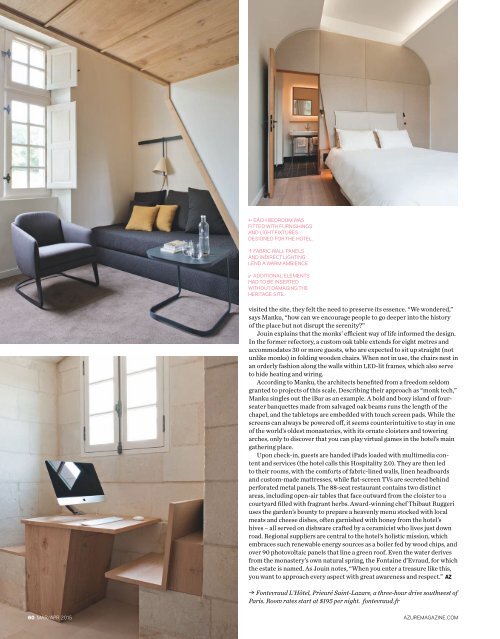AZURE 2015-03-04
Create successful ePaper yourself
Turn your PDF publications into a flip-book with our unique Google optimized e-Paper software.
← each bedroom was<br />
fitted with furnishings<br />
and light fixtures<br />
designed for the hotel.<br />
↑ fabric wall panels<br />
and indirect lighting<br />
lend a warm ambience.<br />
↙ additional elements<br />
had to be inserted<br />
without damaging the<br />
heritage site.<br />
visited the site, they felt the need to preserve its essence. “We wondered,”<br />
says Manku, “how can we encourage people to go deeper into the history<br />
of the place but not disrupt the serenity?”<br />
Jouin explains that the monks’ efficient way of life informed the design.<br />
In the former refectory, a custom oak table extends for eight metres and<br />
accommodates 30 or more guests, who are expected to sit up straight (not<br />
unlike monks) in folding wooden chairs. When not in use, the chairs nest in<br />
an orderly fashion along the walls within LED-lit frames, which also serve<br />
to hide heating and wiring.<br />
According to Manku, the architects benefited from a freedom seldom<br />
granted to projects of this scale. Describing their approach as “monk tech,”<br />
Manku singles out the iBar as an example. A bold and boxy island of fourseater<br />
banquettes made from salvaged oak beams runs the length of the<br />
chapel, and the tabletops are embedded with touch screen pads. While the<br />
screens can always be powered off, it seems counterintuitive to stay in one<br />
of the world’s oldest monasteries, with its ornate cloisters and towering<br />
arches, only to discover that you can play virtual games in the hotel’s main<br />
gathering place.<br />
Upon check-in, guests are handed iPads loaded with multimedia content<br />
and services (the hotel calls this Hospitality 2.0). They are then led<br />
to their rooms, with the comforts of fabric-lined walls, linen headboards<br />
and custom-made mattresses, while flat-screen TVs are secreted behind<br />
perforated metal panels. The 88-seat restaurant contains two distinct<br />
areas, including open-air tables that face outward from the cloister to a<br />
courtyard filled with fragrant herbs. Award-winning chef Thibaut Ruggeri<br />
uses the garden’s bounty to prepare a heavenly menu stocked with local<br />
meats and cheese dishes, often garnished with honey from the hotel’s<br />
hives – all served on dishware crafted by a ceramicist who lives just down<br />
road. Regional suppliers are central to the hotel’s holistic mission, which<br />
embraces such renewable energy sources as a boiler fed by wood chips, and<br />
over 90 photovoltaic panels that line a green roof. Even the water derives<br />
from the monastery’s own natural spring, the Fontaine d’Evraud, for which<br />
the estate is named. As Jouin notes, “When you enter a treasure like this,<br />
you want to approach every aspect with great awareness and respect.”<br />
→ Fontevraud L’Hôtel, Prieuré Saint-Lazare, a three-hour drive southwest of<br />
Paris. Room rates start at $195 per night. fontevraud. fr<br />
60 mar ⁄ apr <strong>2015</strong><br />
azuremagazine.com


















